SEARCH






|
|
|
|


by Editor Miro Susta
What do we know about monkeys, how they live, about their behaviour, about dangers they are exposed to? Enough or possibly very little?
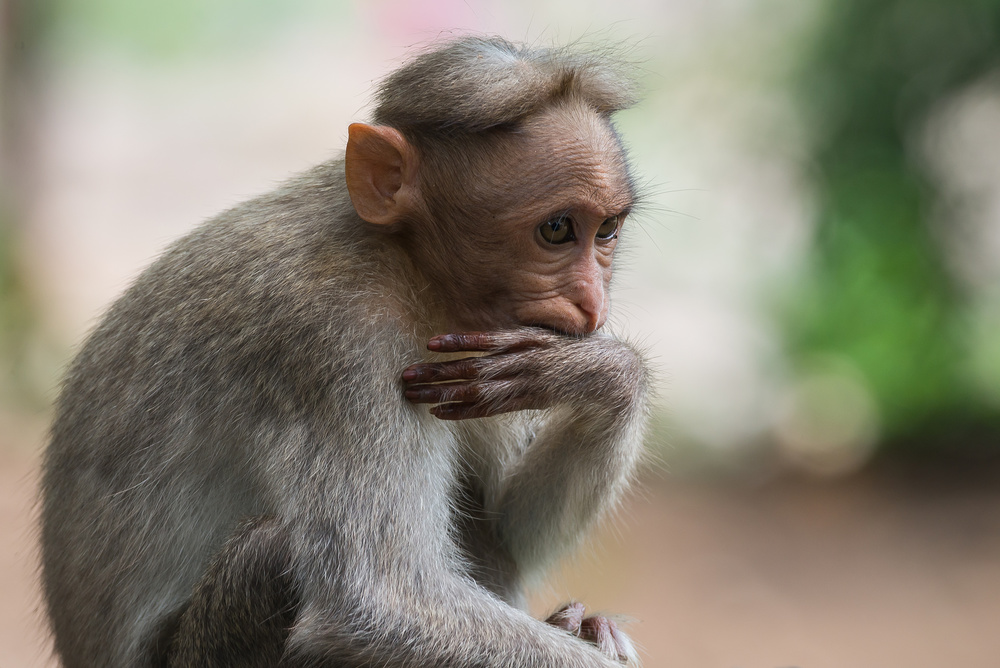
'What had happened?' by Miro Susta
Regardless of the answer to these questions, it is a sad fact that of the nearly 500 species of monkeys on earth, every second is threatened in its present existence.
Whether tiny creatures like the dwarf mouse macaws with their 50 grams or colossuses like the 200 kilogram gorillas, they all suffer from the destruction of their habitat. Chainsaws and bulldozers destroy an area of rainforest equivalent to 35 football fields every minute.

'Enlightenment' by Ashley Vincent
1X photographers travelled on the tracks of our oppressed relatives in different countries and created an excellent photo gallery of miscellaneous monkey species - supplemented by information about their peculiarities, specific characteristics and preferences.
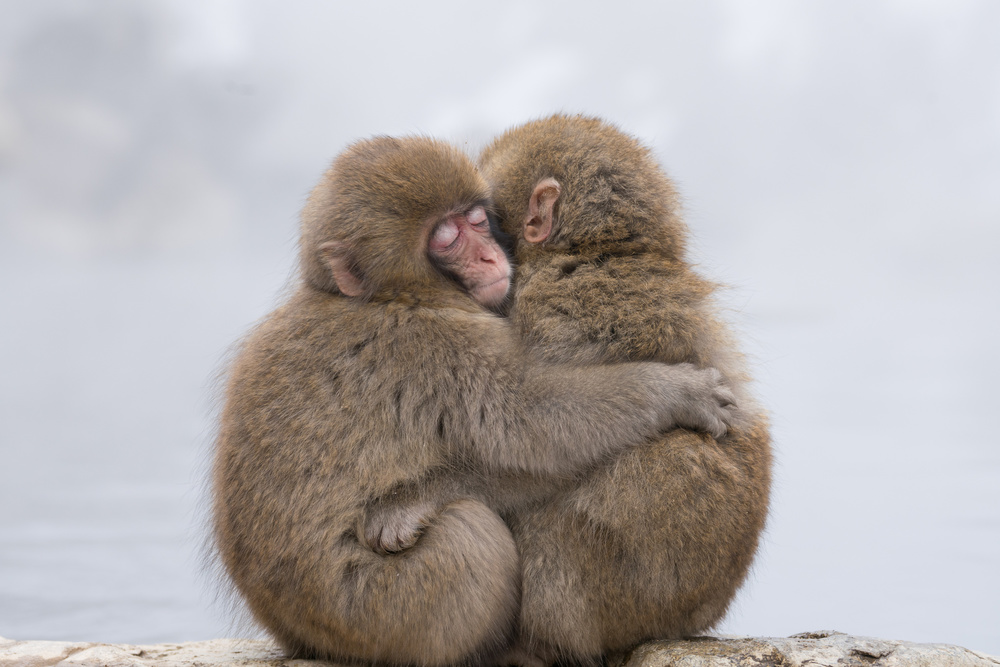 'Forever Friends' by Takeshi Marumoto
'Forever Friends' by Takeshi Marumoto
SNOW MONKEYS
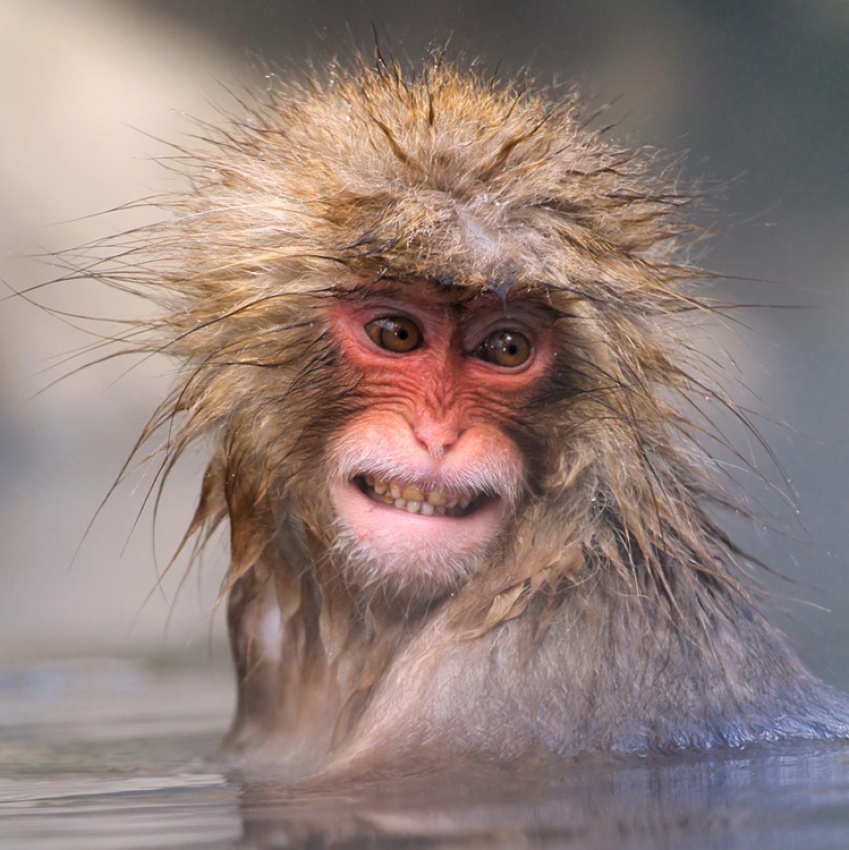 'Smiling Punk' by Harry Eggens
'Smiling Punk' by Harry Eggens
Almost every winter day the Snow Monkeys living in Japan declare a bathing day. In winter, from December to April, they spend hours every day in 35°C to 40°C hot water.
Some monkeys have even learned to dive. No other monkey species in the world lives in colder regions.
Rank among the snow monkeys? Very simply, while the older fellow takes a bath, the young animal is busy with the social fur-care.
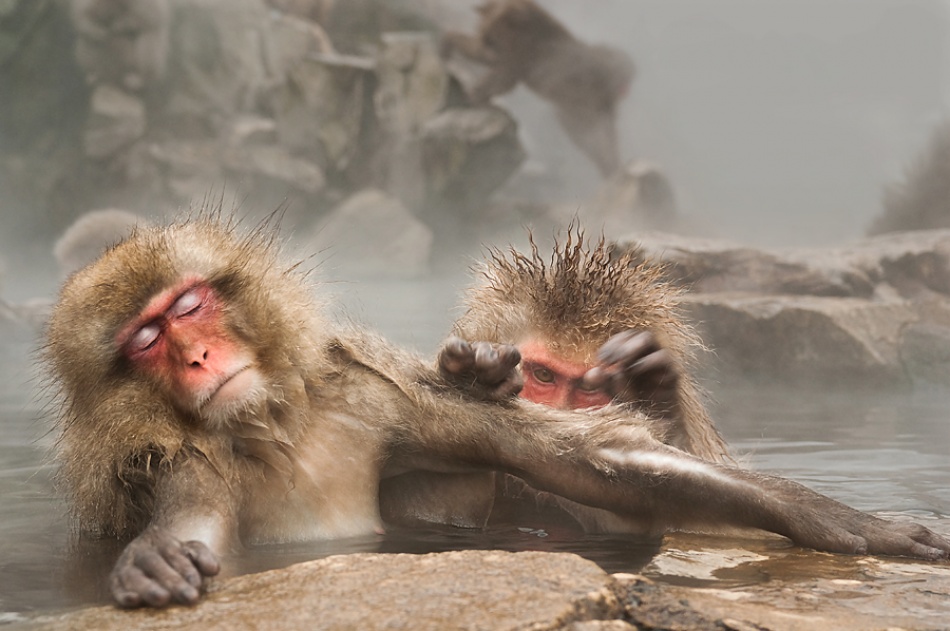
'Snow Monkeys' by Svjetlana Smoljan
One often sees bathing Snow Monkeys in a kind of resting state. The animals let their arms hang over the edge of the pool and enjoy warm water in peace.
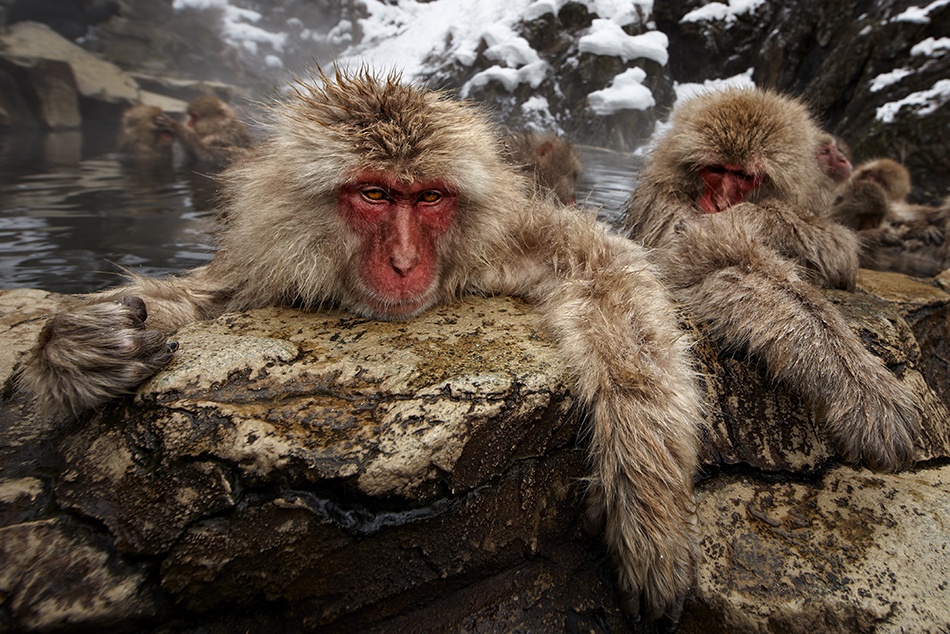
'MONKEY'S SAUNA' by Alessandra Meniconzi
Even park rangers, photographers, tourists and other passers-by do not disturb them.
Each group is led by a so-called alpha male. He enjoys the greatest respect among all group members and ensures cohesion among them.
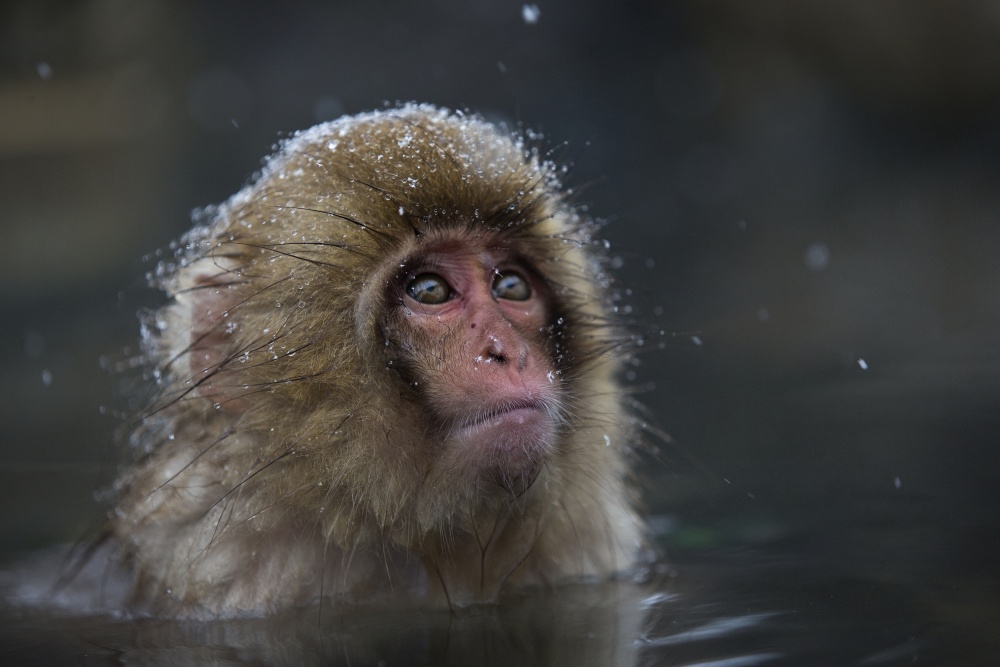
'It's snowing again' by C.S.Tjandra
Snow Monkeys are very peaceful animals, the offspring is cared for not only by their own parents, but by the whole group.
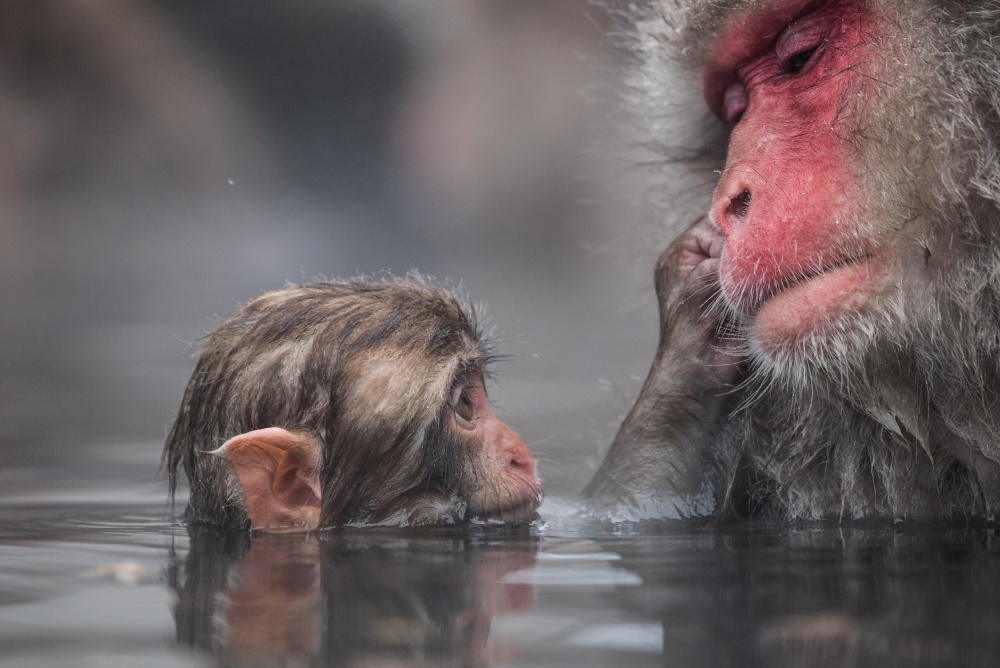
'Family ties' by Takeshi Marumoto
CHIMPANZEES
Besides Bonobos, Chimpanzees are the closest relatives of humans - the genetic material of Chimpanzees and humans is 98% identical.
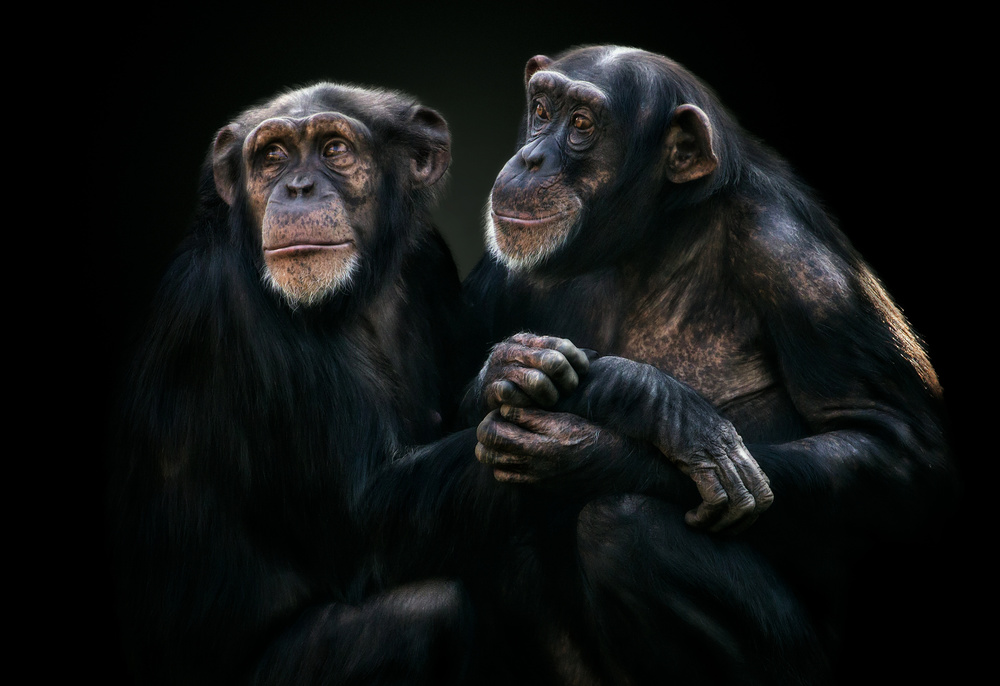
'Just let us be' by Pedro Jarque
Chimpanzees belong to the smaller ape-types. The males somewhat bigger and clearly more massive than the females. Standing adult male monkey reach a size of about 1.2 meters. Males weigh about 28 to 70 kilograms, females are slightly smaller and lighter weighting about 20 to 50 kilograms.
Chimpanzees are robust and sporty. They have a muscular body and are very good climbers. At the ground, they move four-footed in the so-called ankle-walk. But the animals can run short distances also upright on two legs.
ORANG-UTANS
Orang-Utan means "people of the forest" in Indonesian and Malaysian Language. They are extremely peaceful animals - but unfortunately this does not prevent them from being threatened with extinction because their habitat, the rainforest, continues to be destroyed.
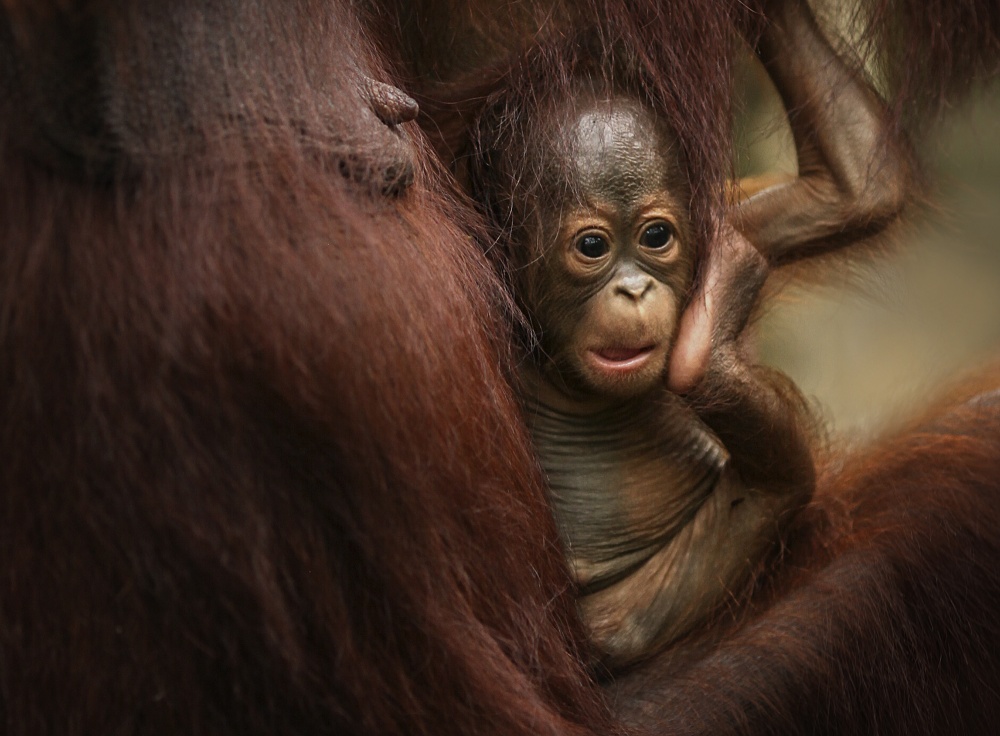
'Toothache :-))' by Faqih Zaback
There are several reasons for deforestation, for example logging, because tropical timber can be sold well; replacing tropical forest by palm oil plantations, because palm oil is an important raw material for the production of many cosmetic products and foodstuffs such as margarine or chocolate.
Also the increasingly popular biofuel for cars is partly made from palm oil. Due to increasing demand, palm oil plantations are constantly being expanded and more and more rainforests are being cleared. The Orang-Utans lose their habitat, are killed or even kidnapped.
Today there are only less than 60,000 wild Orang-Utans left on Sumatra and Borneo Island.
GORILLA
Gorillas are the largest living monkeys, they can grow up to 1.8 m in size and weigh up to 200 kilograms. They are living in African jungles.
The fur-colour of the Gorillas is brown until dark. As with all apes, their arms are clearly longer than the legs, the span of the outstretched arms amounts to 2 to 2.8 meters.
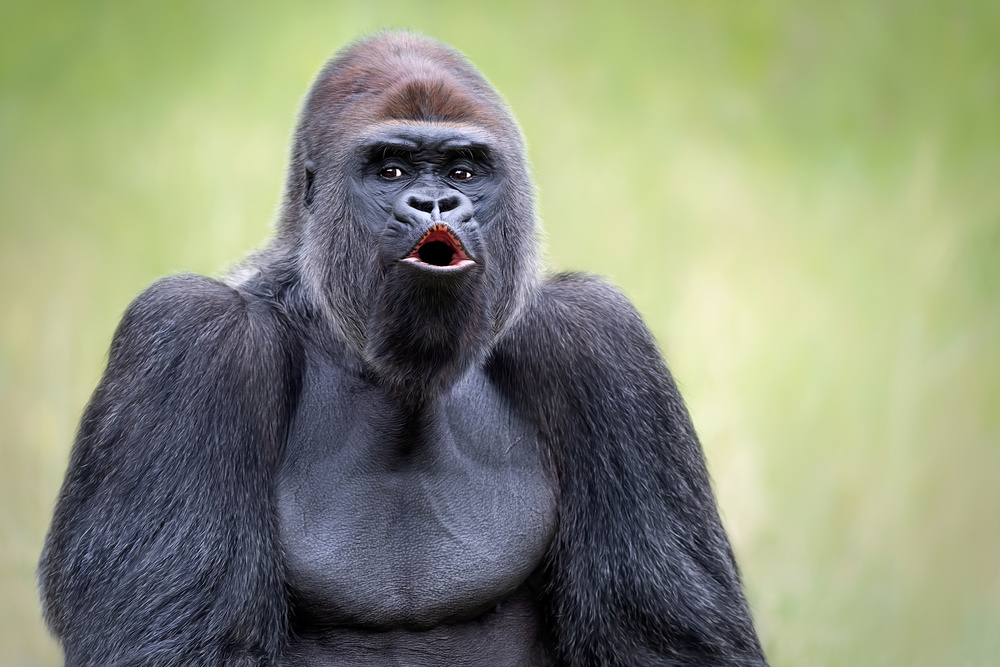
'Herr im Haus' by Bettina Dittmann
All Gorilla species are threatened, albeit to varying degrees. One reason for the threat is the destruction of their habitat by deforestation.
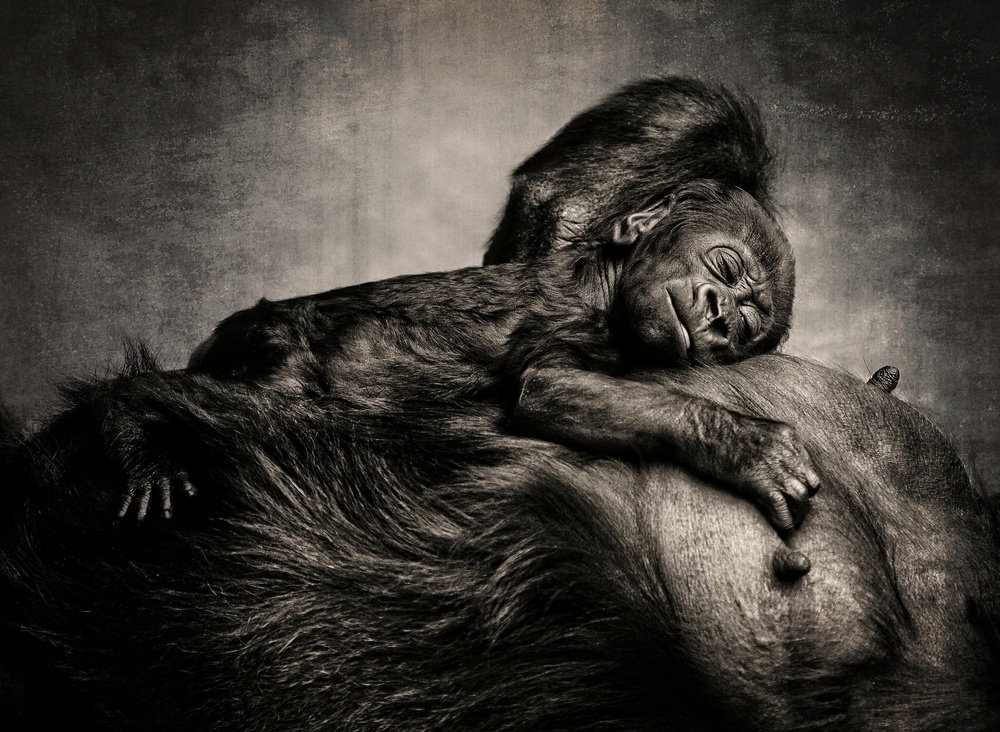
'A CHILD WAS BORN' by Antje Wenner-Braun
In addition, there are civil war-like conditions in parts of their distribution area, which make the necessary protective measures more difficult and make efficient monitoring of protected areas virtually impossible.
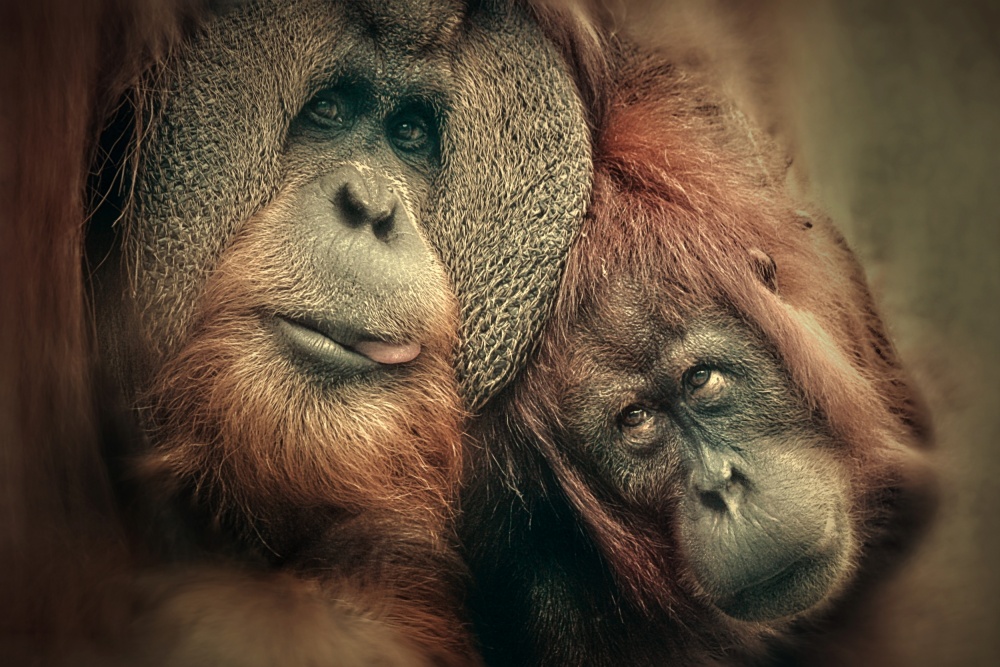
'THE PEOPLE OF THE FOREST' by Antje Wenner-Braun
BABOON (Pavian)
Baboons prefer semi-arid habitats, like Savannah's and bush-lands, but some live in tropical forests and mountains, mostly on African continent.
Baboon's main requirements for safe living space are abundant water sources and safe sleeping places - either in tall trees or on rock faces.
New studies show that male Baboons are constantly harassing females to increase their chances of having sex. It could shed light on the origin of sexual violence in humans.
nfortunately, Baboons are often deliberately poisoned and killed in other ways because they are more likely to be considered pests.
They are also hunted for their skin - this is common with sacred Baboons. The use of Baboons in laboratories and medical research has also increased.
BONNET MACAQUE
Bonnet Macaque monkey is endemic exclusively in south-east India. The Bonnet Macaque is so called, because it has a cap-like fur roll on its head, which points from the middle outward. The overall colouration of this animal is dark brown to golden yellow with a red face and big ears and lower lip.
Suitable habitats for this species are evergreen semi-high mountain hills and dry deciduous forests, however, they can occasionally be observed also in dry prairies. They normally spend much of their time on the ground, but sleep in the trees.
This monkey species is locally abundant in south and south-east India. According to the Indian Institute of Technology in Madras statement, about 170,000 Bonnet Macaques live in the four southern states of India.
WHITE-HEADED LANGUR
The White-Headed Langur is extremely endangered monkey species. It belongs to the rarest primates of the world.
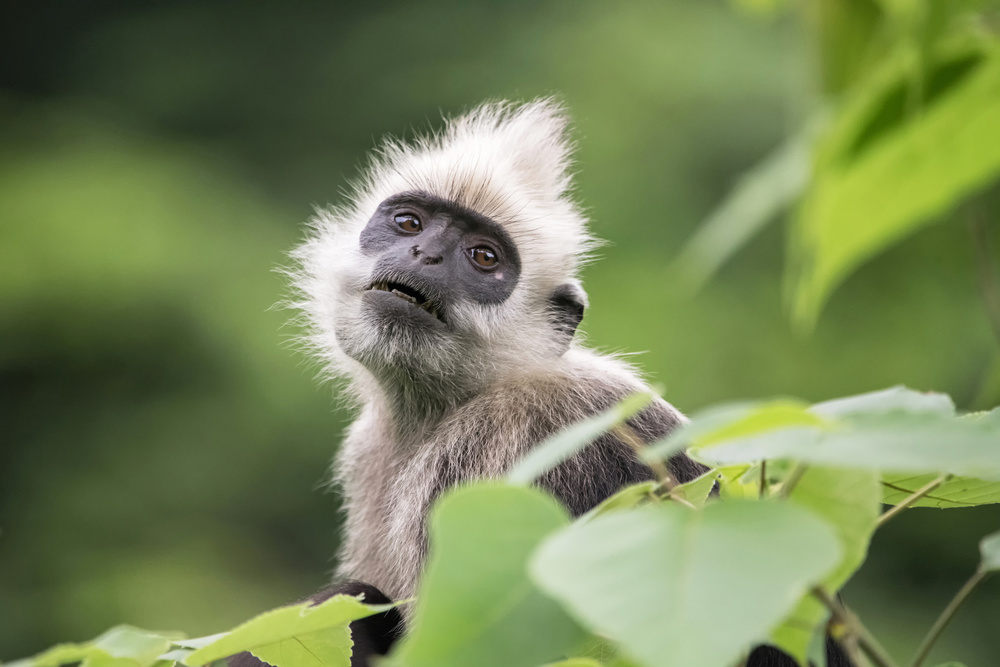
'White-headed langur' by Hao Jiang
Its total worldwide population is estimated at only 1100. More than ninety percent of them live in Guangxi Province in China, where they are protected at the national level.
LEMURS
Lemurs belong to the group of Wet-Nosed Monkeys. From today's point of view, there are around 100 species in the taxon. Lemurs occur exclusively on Madagascar and smaller islands in the proximity.
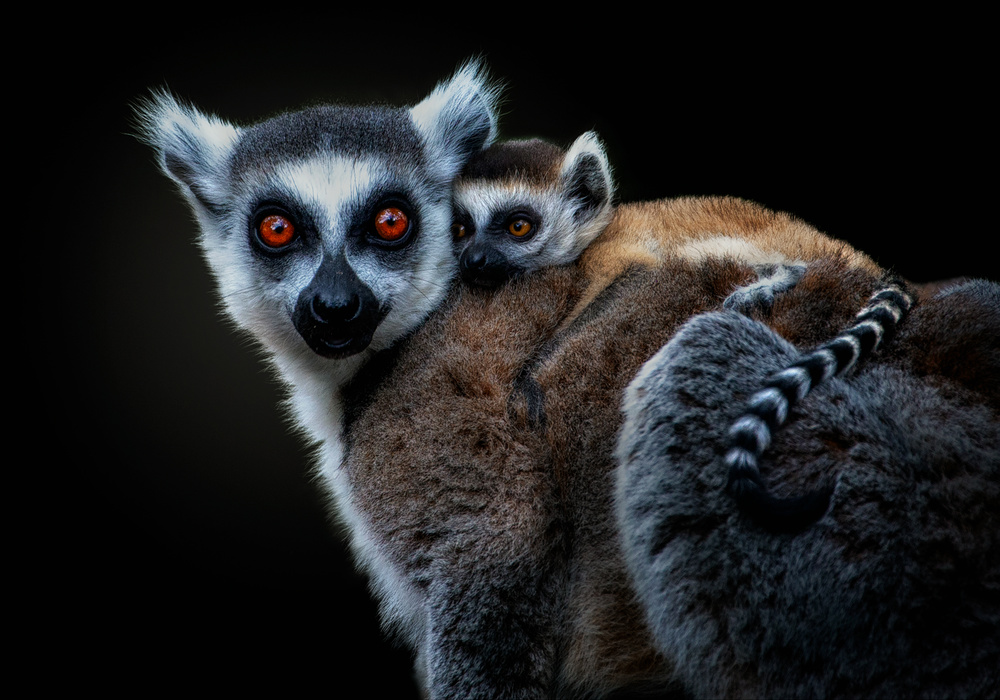
'Indestructible bond' by Pedro Jarque
But Lemur’s habitat is getting lost. Today only about 20% of Madagascar's surface area is covered by forest. The loss of trees is a major threat to the Lemurs, who mainly live in treetops.
MORE INTERESTING FACTS ABOUT MONKEYS.
* Males from the Capuchin monkeys are peeing to lure the females.
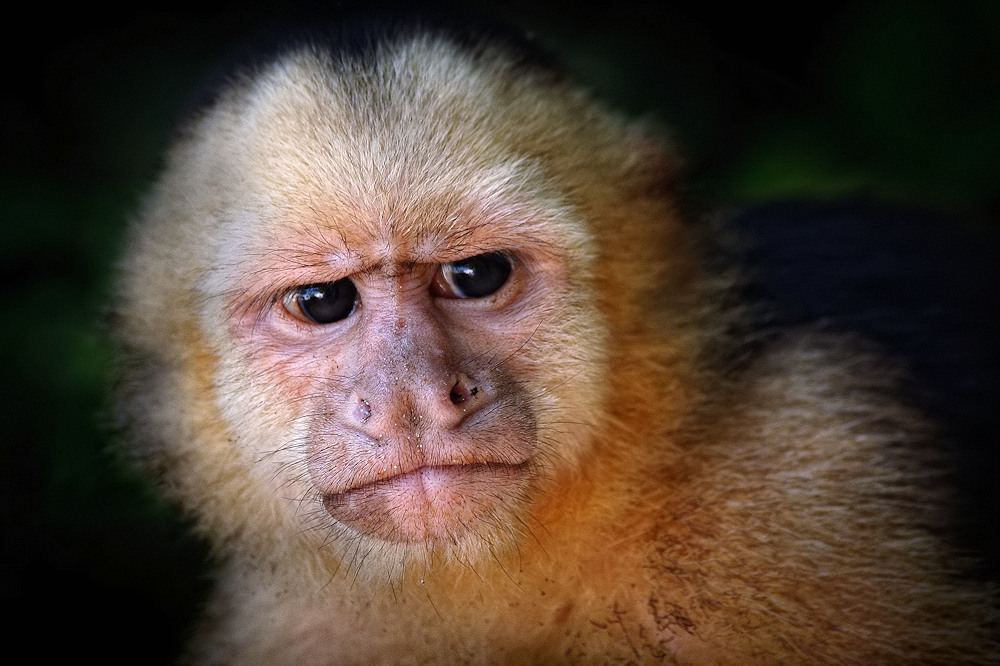
'Capuchin monkey' by jimmy hoffman
* At coconuts plantations in Malaysia and Thailand, monkeys are used to harvest coconuts.
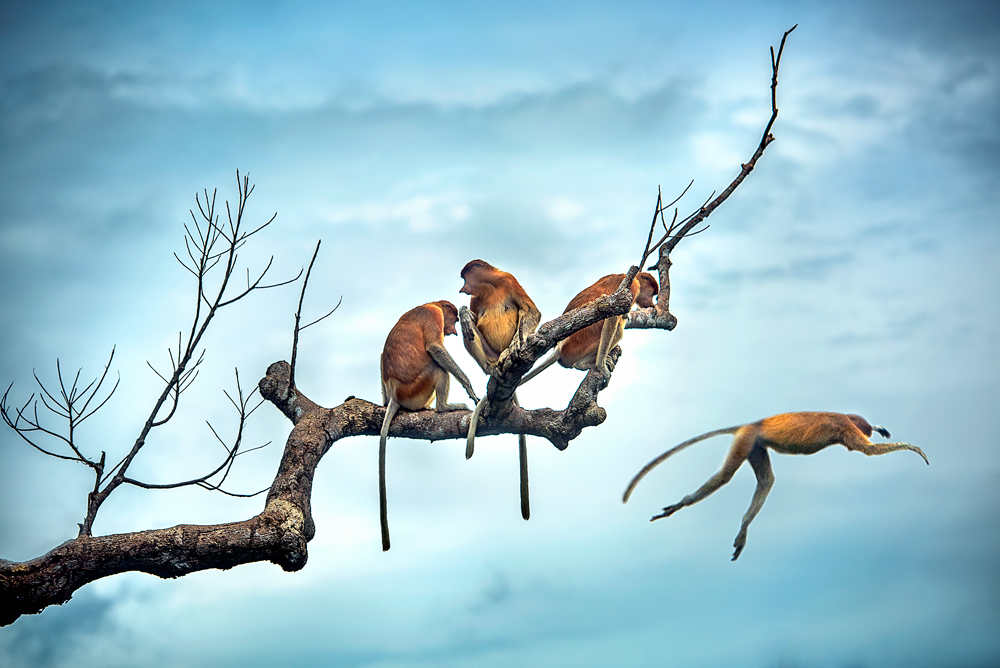
'lining to jump' by rooswandy juniawan
* Berber-monkeys live as single Makaken art on Gibraltar rocks in Europe, only wild monkeys living in Europe (introduced by humans).
* The character of Master Yoda from Star Wars movie was played by a monkey.
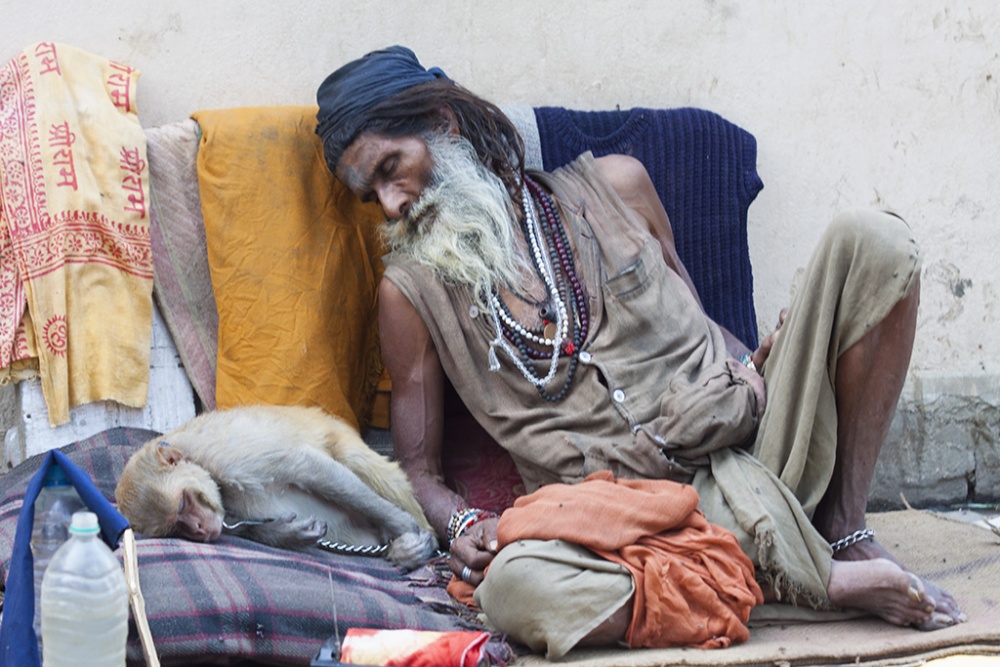
'Sleeping in Varanasi' by Dmitry Below
* In March 2017, monkeys rescued the lost tourist after 9 days in the Amazon forest. They showed him the way to water, food, and eventually led him back to civilization.
* Monkeys also have their own unique set of fingerprints just like humans do.
* Monkeys can be divided into two groups, Old World monkeys that live in Africa and Asia, and New World monkeys that live in South and Central America.
* While monkeys and apes are related, they are very different from each other. Monkeys have tails, have snouts, and they are not as intelligent as apes. Additionally, apes are not found in North or South America or Europe, while monkeys are.
* Monkeys live on all inhabited continents of the earth, with exception of Australia.
* Monkeys eat mainly vegetable food that they find in its habitat the tropical rain-forest. These include mushrooms, nuts, sweet tree sap, seeds and other plant parts such as flowers, leaves and root tubers.
* However, baboons and chimpanzees are omnivores, who eat plant as well as animal food, especially insects, spiders, bird eggs and small vertebrates.
* The life expectancy of the monkeys typically amounts to 10 to 15 years. Apes (Orang Utans and Gorillas) reach 35 to 50 years in the wild.
* The smallest monkey in the world is as big as a golden hamster: it is the dwarf silk monkey (15 cm long – 150 gram weight).
* The largest living primates are the gorillas. They can grow up to 1.75 metres and weigh up to 200 kilograms.
At the end of this article a story to warn: Green Monkey took home woods and ultimately life.
The Green Monkey lost its home due to rainforest felling. She fell into a deadly trap and died in pain just because people wanted more wood.
Sad shots of the Green Monkey female appeared in Patrick Rouxel's film. He seeks to draw attention to the situation in national parks in Indonesia, where brutal deforestation is taking place. For this reason, countless animals are lost here. Informed about the portal dailymail.co.uk.
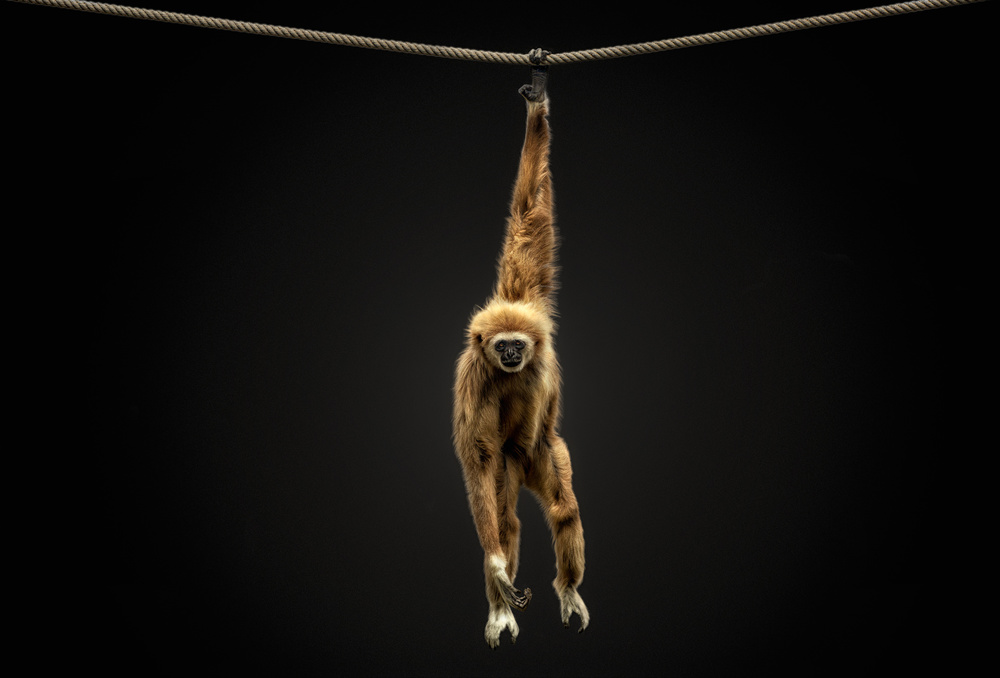
'Hanging by a thread' by Pedro Jarque
The helpless monkey lay in the space where the rainforest used to be. However, due to deforestation, the site turned into a deadly muddy trap. The film shows how people try to save her. They pull it out of the mud and carry it to the hut in the middle of the forest.
Apparently the monkey suffered serious injuries that caused paralysis of half of Greene's body. The author of the documentary was filming her last days, which she was wasting in a shelter. One morning, however, the camera only caught the empty mattress of her bed.
Green's death was caused by the devastation of the tropical forest that left her homeless. Her life was redeemed by wood, paper, pulp, palm oil and Biofuel.
Thanks to all the photographers involved for the great photos.
 | Write |
 | Arbain Bain Very interesting erotic. thank you very much for including my photo
|
 | Rooswandy Juniawan PRO good article my friend, thanks for including my pict |
 | Miro Susta CREW Many thank for nice comment Rooswandy. |
 | Marco Pozzi PRO Very nice portfolio |
 | Miro Susta CREW Thanks Marco. |
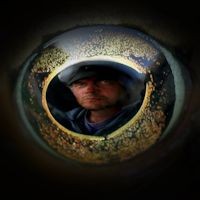 | Jimmy Hoffman Beautiful pics and interesting article!Thanks for including my picture. |
 | Miro Susta CREW Jimmy I am glad to see that you like this article; many thanks for your contribution. |
 | Phillip Chang CREW Wonderful collections! Love every piece. Thank you for including my picture! |
 | Miro Susta CREW Many thanks Pedro for your appreciation and for your contribution. |
 | Pedro Jarque Krebs PRO Beautiful work! Thanks for including me.
|
 | Miro Susta CREW Many thanks Pedro, also tank you for your contribution. |
 | Jaco Marx PRO Wonderful piece! Love the content.
Thank you for the inclusion guys! Appreciate it. |
 | Miro Susta CREW Thanks Jaco for your contribution and appreciation. |
 | Eduardo Blanco García PRO Excellent report. I loved |
 | Miro Susta CREW Thank you Mario for your appreciation. |